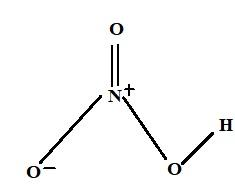
Concentrated \[{{NH}}{{{O}}_{{{3}}\,\,\,}}\] forms \[{{NO}}_{{2}}^{{ + }}\] in the presence of:
A. Con. \[{{{H}}_{{2}}}{{S}}{{{O}}_{{4}}}\]
B. \[{{Fe}}\]
C. \[{{FeB}}{{{r}}_{{{3}}\,}}\]
D. \[{{AlC}}{{{l}}_{{3}}}\]
Answer
545.4k+ views
Hint: \[{{HN}}{{{O}}_{{{3}}\,\,\,}}\] is a strong acid. It is also known by the spirit of niter and aqua fortis. It is colourless but as it gets older it turns into a yellow in colour. This is due to the decomposition of nitric acid into oxides of nitrogen and water.
Complete step by step answer:
It is used as a strong oxidizing agent. It is synthesised from ammonia by catalytic oxidation. It is a major chemical used in industries to manufacture explosives and fertilizers. The ${{pH}}$ of Nitric acid is around \[3.01\]. Structurally, this molecule contains three oxygen atoms, one nitrogen atom, and one hydrogen atom. Here, one of the oxygen atoms is doubly bonded with the central nitrogen atom. Another oxygen atom is bonded singly with the central nitrogen atom and the oxygen is also singly bonded with the hydrogen atom. The oxygen atom that is singly bonded to the central nitrogen atom has a charge of $ - 1$. The central nitrogen atom of the molecule is participating in four covalent bonds (with 3 oxygen atoms), it has a charge of $ + 1$. Thus, the net charge on the nitric acid molecule is zero. The charges here can be delocalized due to resonance. The structure of nitric acid molecules can be represented as,

Concentrated nitric acid reacts with sulphuric acid to form \[{{NO}}_{{2}}^{{ + }}\], the equation is represented as,
\[{{O}}{{{H}}^{{ - }}}\,\,{{ + }}\,\,{{{N}}^{{ + }}}{{O}}_{{2}}^{}\,\,{{ + }}\,\,{{{H}}_{{2}}}{{S}}{{{O}}_{{4}}}\,\, \to \,{{{H}}_{{2}}}{{O}}\,\,{{ + }}\,\,{{{H}}_{{2}}}{{S}}{{{O}}_{{4}}}\,\]
So, the correct answer is Option A.
Additional Information:
It is highly corrosive and toxic. It causes severe skin burn. It reacts with hydroxides, metals, and oxides to form nitrate salts.
Note: Some of the application of nitric acid are:
It is used to manufacture dye, and fertilizers.
It can be used in manufacturing explosives such as TNT.
It is used as an oxidizer in liquid-fuelled rockets.
It is in electrochemistry as a chemical doping agent.
Complete step by step answer:
It is used as a strong oxidizing agent. It is synthesised from ammonia by catalytic oxidation. It is a major chemical used in industries to manufacture explosives and fertilizers. The ${{pH}}$ of Nitric acid is around \[3.01\]. Structurally, this molecule contains three oxygen atoms, one nitrogen atom, and one hydrogen atom. Here, one of the oxygen atoms is doubly bonded with the central nitrogen atom. Another oxygen atom is bonded singly with the central nitrogen atom and the oxygen is also singly bonded with the hydrogen atom. The oxygen atom that is singly bonded to the central nitrogen atom has a charge of $ - 1$. The central nitrogen atom of the molecule is participating in four covalent bonds (with 3 oxygen atoms), it has a charge of $ + 1$. Thus, the net charge on the nitric acid molecule is zero. The charges here can be delocalized due to resonance. The structure of nitric acid molecules can be represented as,

Concentrated nitric acid reacts with sulphuric acid to form \[{{NO}}_{{2}}^{{ + }}\], the equation is represented as,
\[{{O}}{{{H}}^{{ - }}}\,\,{{ + }}\,\,{{{N}}^{{ + }}}{{O}}_{{2}}^{}\,\,{{ + }}\,\,{{{H}}_{{2}}}{{S}}{{{O}}_{{4}}}\,\, \to \,{{{H}}_{{2}}}{{O}}\,\,{{ + }}\,\,{{{H}}_{{2}}}{{S}}{{{O}}_{{4}}}\,\]
So, the correct answer is Option A.
Additional Information:
It is highly corrosive and toxic. It causes severe skin burn. It reacts with hydroxides, metals, and oxides to form nitrate salts.
Note: Some of the application of nitric acid are:
It is used to manufacture dye, and fertilizers.
It can be used in manufacturing explosives such as TNT.
It is used as an oxidizer in liquid-fuelled rockets.
It is in electrochemistry as a chemical doping agent.
Recently Updated Pages
A man running at a speed 5 ms is viewed in the side class 12 physics CBSE

The number of solutions in x in 02pi for which sqrt class 12 maths CBSE

State and explain Hardy Weinbergs Principle class 12 biology CBSE

Write any two methods of preparation of phenol Give class 12 chemistry CBSE

Which of the following statements is wrong a Amnion class 12 biology CBSE

Differentiate between action potential and resting class 12 biology CBSE

Trending doubts
What are the major means of transport Explain each class 12 social science CBSE

Which are the Top 10 Largest Countries of the World?

Draw a labelled sketch of the human eye class 12 physics CBSE

Explain sex determination in humans with line diag class 12 biology CBSE

Explain sex determination in humans with the help of class 12 biology CBSE

Differentiate between homogeneous and heterogeneous class 12 chemistry CBSE




